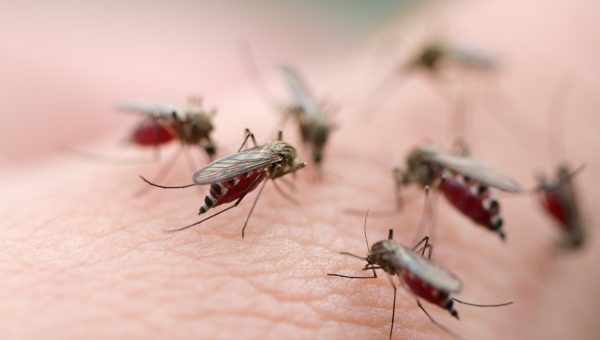13
Jun
Study Provides Insight into Why Mosquitoes Target Certain People Over Others

(Beyond Pesticides, June 13, 2023) The specific compounds that comprise one’s scent influence how attractive one is to mosquitoes finds research published in the journal Current Biology by scientists at Johns Hopkins University. Although the findings focus solely on a species of malaria mosquito primarily distributed throughout Sub-Saharan Africa, the results could provide insight into broader concerns over mosquito disease transmission and public health. As it currently stands, personal protective measures and the use of least-toxic repellents are the best methods to address most mosquito problems in the United States.
Scientists utilized a mixture and semi-field trials to understand first how mosquitoes became attracted to human hosts. For the field trial, a large facility the size of a college lecture hall was utilized to mimic the sort of open space mosquitoes have available to them in the wild. Eight landing boards were placed in a ring and either heated to human temperature, “baited” with carbon dioxide, or both. Researchers then released 200 mated female mosquitoes that had been starved of food. Scientists tracked the mosquitoes through infrared cameras to determine their trajectory.
Only when both heat and carbon dioxide were present did scientists witness high levels of landings on the platforms provided. Neither alone appeared to attract significant mosquito attention.
Researchers then compared the attractiveness of the warmed carbon dioxide platform against that of human odor. Individuals participating in this study were asked to bathe with unscented shampoo, not apply any other scented materials, and refrain from alcohol and tobacco prior to joining the experiment, in order to prevent confounding factors. The results of this process found that malaria mosquitoes strongly sought out the platform with human odor.
The next step was then to compare the mosquito attractiveness of two different humans. In doing so, scientists observed that for six of the seven nights, one human received twice the number of landings than the other. This did not change based on wind currents or the objects’ position.
To further delve into the details as to why the mosquitoes seek out one individual over another, scientists established a cohort of six humans. Over the course of this experiment, one human was found to be more attractive to mosquitoes than any others. At the same time, a different human in the experiment received relatively few mosquito landings.
The body odor of each human in the experiment was then collected by air sampling and evaluated for its chemical breakdown. Scientists found over 1,000 individual chemicals – primarily comprised of volatile compounds released from human skin. In a comparative analysis, carboxylic acids were found to be the class of chemicals that differed most between human subjects. It follows that researchers found that the most attractive human contain the most abundant number of these molecules, while the least attractive human have the least amount. Interestingly, the least attractive human contains significantly higher levels of one specific carboxylic acids – eucalyptol. As readers may recognize, this is a compound that is also found in many aromatic plants that are known to repel mosquitoes.
The final results appear to buttress the assumptions many people have about mosquitoes – that this or that person is more attractive to mosquitoes than others. However, U.S. readers should be cautious with these results since the study focused on a mosquito that is not found in the U.S.
Scientists are keen on further research that expands the size of the experiment to better understand inter-individual variability in attractiveness. There is also an interest in these results eventually leading to new traps, repellents, or other nontoxic methods of mosquito management.
If you are someone that knows mosquitoes love to feed on you, personal protection is even more important. See Beyond Pesticides factsheet on least-toxic mosquito repellents for information on how to repel these dangerous pests safely. Toxic pesticides and genetic modification should never be the first line of defense for mosquitoes -an ecological approach that focuses primarily on public education and source reduction is the best way to address community mosquito problems. Read more about the benefits of safer mosquito management here.
All unattributed positions and opinions in this piece are those of Beyond Pesticides.
Source: Current Biology











Recent research has revealed that mosquitoes prefer specific individuals based on their body odor and genetics. This study sheds light on the complex interactions between mosquitoes and humans and underscores the need for innovative approaches to mosquito control.
June 26th, 2023 at 3:20 amI always knew that even mosquitoes had their preference. I didn’t know there was scientific backing behind the same, though.
July 31st, 2023 at 6:32 am